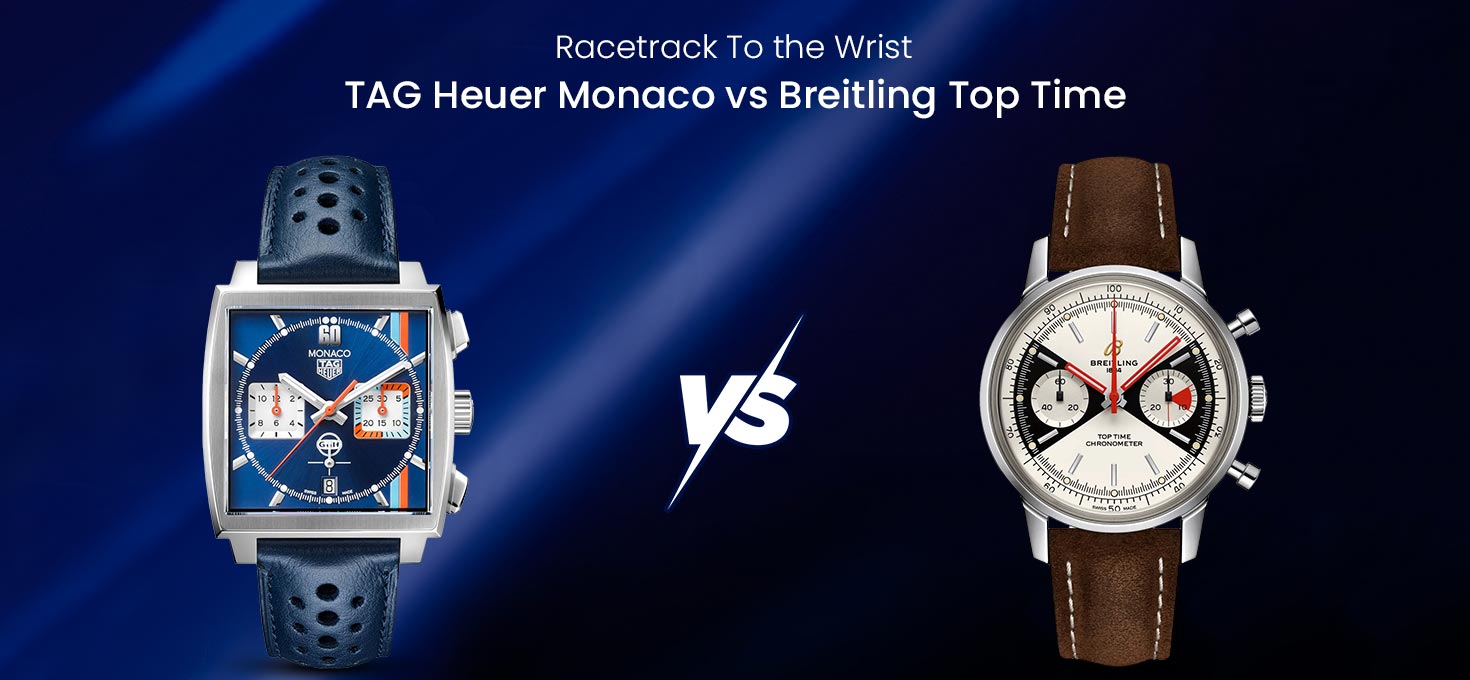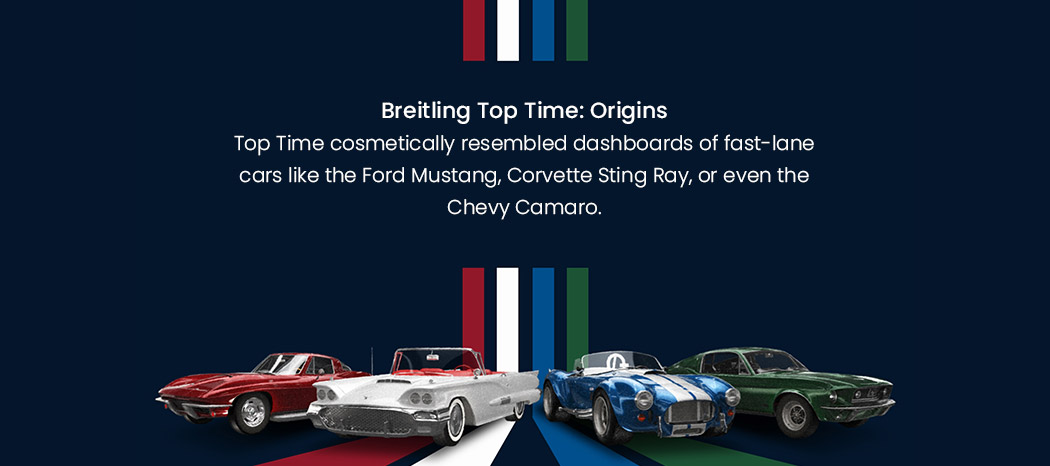 Reading Time: 6 minutes
Reading Time: 6 minutes
Motorsports has flirted with watchmaking on-and-off-track for nearly a century, creating icons in the process. Those golden (engine) roars of the Sixties can be heard to date. With post-war modernism taking over the world, watchmakers, too, sought new paths — Patek Philippe embraced the art of hyper-mechanical brilliance, OMEGA took to the cosmos, Breitling focused on chronometric accuracy, and TAG Heuer ‘reshaped’ their appearance. Two prominent creations from the ‘60s were the Breitling Top Time and TAG Heuer Monaco – one inspired by the vibrancy of sportscars and the other by the adrenaline of the racetrack.

Today, we’re comparing these two motoring icons, tracing their legacies back to their origin, their evolution through time and the icons they’ve become today — Here’s everything you need to know about the TAG Heuer Monaco and Breitling Top Time.
Breitling Top Time: Origins

In the early Sixties, Breitling had a mission: chronometric accuracy. Sure, the Navitimer and Chronomat already were Breitling’s paean of accurate timekeeping. Still, the boomers of the era yearned for a departure from traditional, mid-century designs, and a completely fresh take on the chronograph. Enter, the Breitling Top Time, personifying this generation’s spirit of modern accuracy.
First introduced in 1964, it boasted clean lines, a splash of vibrancy, and sporty double-register chronographs resembling Zoro’s mask or bowties. Soon, Breitling added a third chronograph register while also experimenting with panda and reverse-panda dials variants – all cased in stainless steel, gold-plating, or 18-carat yellow gold to infuse a dose of elegance. For most, the Top Time cosmetically resembled dashboards of fast-lane cars like the Ford Mustang, Corvette Sting Ray, or even the Chevy Camaro. Sadly, as Breitling closed its doors in 1978 and was sold, the legacy of the racy Top Time came to a halt. But nearly half a century later, as Breitling found a new CEO (Georges Kern) in 2017, the Top Time was soon reinstated for duty and given a second life. Embracing its retro-chic racing aesthetics, the new Top Time proudly retains its original recipe for success: simple, sporty, and a fresh take on chronographs.
TAG Heuer Monaco: Origins

The year is 1969 and the race was on (for automatic chronograph watches). Heuer joined forces with Breitling, Hamilton-Buren, and Dubois-Depraz to unveil the ‘Project 99’ – an automatic chronograph movement with a rewinding system that would revolutionize the watch industry. Officially launched as the Calibre 11, Heuer’s new movement demanded a larger case size to accommodate its advancements. Initially destined to be housed in the Carrera and Autavia collections which would allow it to be marketed to aviation and automobile enthusiasts, Jack Heuer took an unexpected decision. He partnered with Erwin Piquerez, a Swiss case manufacturer, striving to introduce an entirely new case silhouette for the Calibre 11. Heuer challenged the status quo of watchmaking design with a square-shaped case that guaranteed waterproofness. With two chronometric registers at three and nine o’clock and a date window at six, Heuer’s latest creation took its name after the legendary Monaco Formula One race – creating the ultimate sports chronograph for motorsport lovers.
When Bond Went Breitling

The fourth James Bond film, Thunderball, was released in 1965, and anyone would’ve guessed 007’s watch to be an OMEGA. However, things were different back then, and Bond had other preferences. While Bond (Sean Connery) wore a Breitling, it surprisingly wasn’t a Navitimer (Ref. 308). In fact, Francois Derval, a French NATO pilot, was featured wearing this chronometric icon – Bond, on the other hand, wore a one-of-a-kind Top Time. The Breitling Top Time Ref. 2002 played a special supporting role in the film, winning the hearts of Bond fans and watch geeks. In the film, this Top Time was modified by Q to feature a Geiger counter – which helped Bond detect radiation emitted from the two nuclear warheads he was quested to find. Tragically, this one-of-one timepiece, built especially for Thunderball, went missing after the film’s production. This pop culture relic was lost in time, only to end up at a Christie’s auction in 2013, where it sold for over £100,000.
Le Mans: TAG Heuer Monaco’s Legacy of Endurance
As Heuer launched the Calibre 11, he struck a deal with brand friend and Formula 1 driver Jo Siffert, who served as production support for 1970’s Le Mans. While the “King of Cool”, Steve McQueen, was originally meant to sport an Autavia in the film, Siffert swapped it out for a Monaco 1133B for its counter-culture appearance. This went down as one of film history’s most successful movie product placements.
During the ‘70s, McQueen was the movie star and a prominent race car driver, placing second in the 12 Hours of Sebring driving a Porsche 908/02. Making him a silver-screen star as well as a prominent motorsport personality with tons of fans – the kind of folks TAG Heuer was targeting for the Monaco. The square-cased, blue-dialed icon retailed for $400 at launch, but thanks to the “McQueen” effect, the original movie piece sold for $2.2 million in 2020 at a Philipps auction.
Signature Aesthetics – TAG Heuer Monaco vs Breitling Top Time
Upon close inspection, you’ll notice that Breitling’s Top Time lacks any definitive or signature cuts, shapes, or secret ingredients – yet they’re instantly recognizable. In my opinion, what makes the Top Time ‘tick’ differently is its dial’s unapologetic vibrancy. Since its recommissioning in 2022, the Top Time has embraced its retro-chic motoring aesthetics and spared no measures in draping their dials with them. With a simplistically round stainless-steel case with dual chronograph pushers at two and four o’clock and strapped in leather, its dial retains its double and triple-register layouts from the Sixties and a refreshing splash of motoring-inspired colourways. Each dial hue is designed to emulate the freedom and adrenaline of cruising on a motorcycle or revving up a sportscar – perhaps that’s the Breitling Top Time’s signature feat.
On the other hand, the Monaco lives and breathes motorsport, and its most quintessential feat is its legacy with racing. Aesthetically defined by its square silhouette since ‘69, this case’s sharp geometrics were designed to stand out in a sea of round-cased watches. The clean-cut stainless steel square case is paired with signature chronograph pushers, while the dial is commonly adorned in a deep blue hue with splashes of racing red, evoking the rush and colours of motorsport. First launched in 1969, the Monaco was the world’s first automatic chronograph encased in a water-resistant square case. Fifty years later, the Monaco is recognized as a symbol of precision and performance. Through these generations, the Monaco has taken many aesthetical forms, but its double-register chronograph and date window layout have remained consistent.
Current Configurations – Breitling Top Time
All contemporary Breitling Top Time models are cased in 41 millimetres of stainless steel, being 13.3 millimetres thick. While all straps are stitched out of leather, they arrive in various colours depending on the model (brown, black, red). Dial colours are inspired by the paint jobs of iconic retro cars like the Ford Mustang (Green), Ford Thunderbird (White), Shelby Cobra (Blue), Chevrolet Corvette (Red), Triumph Motorcycles (Light Blue), and a standard brown variant. Each dial is badged with an artistic retro logo corresponding to each model’s motoring muse. The Top Time employs two self-winding B01 movement variants which offer 70-hour power reserves, fitted into double-register and triple-register movements.
Current Configurations – TAG Heuer Monaco
At Kapoor Watch Company’s stores, the TAG Heuer Monaco is available in four variants. While each is square-cased in 39 millimetres of brushed stainless steel, they embrace multiple alter-egos of Monaco. Layout-wise, all models feature a signature double register chronograph setup with a date window at six. Traditionally, Monaco’s dial is draped in blue – reminiscent of vintage race car liveries, carried through generations and prominently strut in contemporary catalogues too. The model Ref. CAW2111.FC6356 and Ref. CBL2111.FC6453 are quintessential examples of this racing hue at work. There’s also the Ref. CAW211P.FC6356, which boasts a slightly subtler tone of Monaco Blue. Since 1969, Monaco’s dial has been an experimental creative canvas, dabbling in red, green, and silver hues while taking on skeletonized forms. The model Ref CBL2113.FC6177 perfectly expresses this with its sunray black dial. The TAG Heuer is commonly equipped with a Calibre Heuer 02 which runs automatic with a power reserve of 80 hours. All this is strapped in a three-link steel bracelet or leather.
The post Racetrack To the Wrist: TAG Heuer Monaco vs Breitling Top Time appeared first on Kapoor Watch Co. | Blogs.







